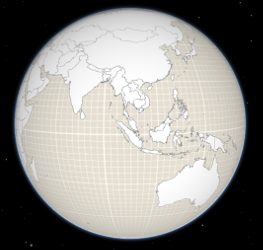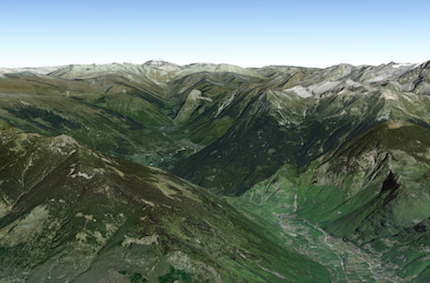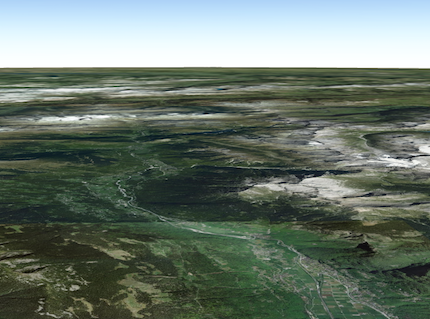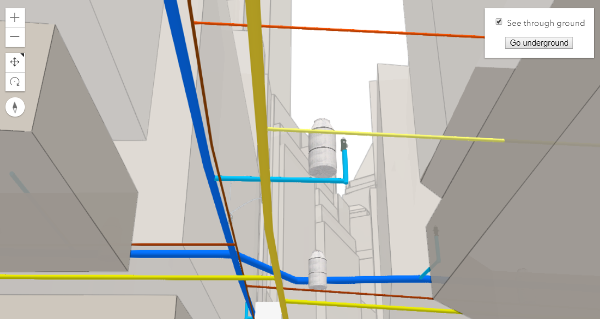require(["esri/Ground"], (Ground) => { /* code goes here */ });
import Ground from "@arcgis/core/Ground.js";
esri/Ground
The Ground class contains properties that specify how the ground surface is displayed in a SceneView. It contains a layers property, which is a collection of ElevationLayer that defines the elevation or terrain of the map's surface.
On a Map instance, a default ground surface using the World Elevation Service can conveniently be initialized through the ground property:
let map = new Map({
basemap: "topo-vector",
ground: "world-elevation"
});
When terrain and bathymetry values are needed, the TopoBathy 3D Service can be used:
let map = new Map({
basemap: "topo-vector",
ground: "world-topobathymetry"
});
When no basemap is available, the Ground displays a grid by default:

That can be changed by setting a color on the surfaceColor property:
map.ground.surfaceColor = '#004c73';

If the scene contains underground data, reduce the opacity of the ground to be able to see through the ground:
map.ground.opacity = 0.4;
Constructors
-
Parameterproperties Objectoptional
See the properties for a list of all the properties that may be passed into the constructor.
Property Overview
| Name | Type | Summary | Class |
|---|---|---|---|
The name of the class. | Accessor | ||
A collection of ElevationLayers that define the elevation or terrain that makes up the ground surface. | Ground | ||
The Error object returned if an error occurred while loading. | Ground | ||
Represents the status of a load operation. | Ground | ||
A list of warnings which occurred while loading. | Ground | ||
Indicates whether the instance has loaded. | Ground | ||
Specifies the user navigation constraints relative to the ground surface. | Ground | ||
Opacity of the ground, including surface default color and the basemap (without reference layers). | Ground | ||
The color of the ground surface, displayed underneath the basemap. | Ground |
Property Details
-
layers
Propertylayers Collection<(ElevationLayer|BaseElevationLayer)>autocast -
A collection of ElevationLayers that define the elevation or terrain that makes up the ground surface. When elevation layers are added to the ground, the topographical variations of the surface are rendered in 3D as they would appear in the real world.

When the layers collection is empty, the ground surface is flat.
 Example
Example// Adds the esri world elevation service to the ground let layer = new ElevationLayer({ url: "//elevation3d.arcgis.com/arcgis/rest/services/WorldElevation3D/Terrain3D/ImageServer" }); map.ground.layers.add(layer);
-
The Error object returned if an error occurred while loading.
- Default Value:null
-
loadStatus
PropertyloadStatus Stringreadonly -
Represents the status of a load operation.
Value Description not-loaded The object's resources have not loaded. loading The object's resources are currently loading. loaded The object's resources have loaded without errors. failed The object's resources failed to load. See loadError for more details. Possible Values:"not-loaded" |"loading" |"failed" |"loaded"
- Default Value:"not-loaded"
-
A list of warnings which occurred while loading.
-
Since: ArcGIS Maps SDK for JavaScript 4.8Ground since 4.0, navigationConstraint added at 4.8. -
Specifies the user navigation constraints relative to the ground surface.
- Property
-
type String
The type of the constraint. It can be one of the following:
Value Description stay-above User can only navigate above ground surface none User can navigate above and below the ground surface Default value: stay-above
Possible Values:"stay-above"|"none"
-
opacity
Propertyopacity NumberSince: ArcGIS Maps SDK for JavaScript 4.8Ground since 4.0, opacity added at 4.8. -
Opacity of the ground, including surface default color and the basemap (without reference layers). This property can be used for a see-through ground effect.
- Default Value:1
-
Since: ArcGIS Maps SDK for JavaScript 4.8Ground since 4.0, surfaceColor added at 4.8. -
The color of the ground surface, displayed underneath the basemap. If this is null, a grid is displayed instead. The alpha value in the color is ignored. Use the opacity property to control the opacity of the ground.
- Default Value:null
Method Overview
| Name | Return Type | Summary | Class |
|---|---|---|---|
Adds one or more handles which are to be tied to the lifecycle of the object. | Accessor | ||
Cancels a load() operation if it is already in progress. | Ground | ||
Creates a deep clone of this object. | Ground | ||
Promise<ElevationSampler> | Creates an elevation sampler for the given extent by querying the ground layers for elevation data and caching it so values may be sampled quickly afterwards. | Ground | |
Destroys the ground and its layers. | Ground | ||
Creates a new instance of this class and initializes it with values from a JSON object generated from an ArcGIS product. | Ground | ||
Returns true if a named group of handles exist. | Accessor | ||
| Ground | ||
| Ground | ||
| Ground | ||
Promise | Loads the resources referenced by this class. | Ground | |
Promise<Ground> | Loads all the externally loadable resources associated with the ground. | Ground | |
Promise<ElevationQueryResult> | Query the ground layer services for elevation values for the given geometry. | Ground | |
Removes a group of handles owned by the object. | Accessor | ||
Converts an instance of this class to its ArcGIS portal JSON representation. | Ground | ||
Promise |
| Ground |
Method Details
-
Inherited from Accessor
Since: ArcGIS Maps SDK for JavaScript 4.25Accessor since 4.0, addHandles added at 4.25. -
Adds one or more handles which are to be tied to the lifecycle of the object. The handles will be removed when the object is destroyed.
// Manually manage handles const handle = reactiveUtils.when( () => !view.updating, () => { wkidSelect.disabled = false; }, { once: true } ); this.addHandles(handle); // Destroy the object this.destroy();ParametershandleOrHandles WatchHandle|WatchHandle[]Handles marked for removal once the object is destroyed.
groupKey *optionalKey identifying the group to which the handles should be added. All the handles in the group can later be removed with Accessor.removeHandles(). If no key is provided the handles are added to a default group.
-
Cancels a load() operation if it is already in progress.
-
clone
Methodclone(){Ground} -
Creates a deep clone of this object.
Returns
-
createElevationSampler
MethodcreateElevationSampler(extent, options){Promise<ElevationSampler>}Since: ArcGIS Maps SDK for JavaScript 4.7Ground since 4.0, createElevationSampler added at 4.7. -
Creates an elevation sampler for the given extent by querying the ground layers for elevation data and caching it so values may be sampled quickly afterwards. The sampler uses the elevation data from the first layer that has data available. For getting elevation data from a specific layer use ElevationLayer.createElevationSampler().
ParametersSpecificationextent ExtentThe extent for which to create the sampler.
options ObjectoptionalAdditional sampler options.
Specificationoptional Default Value: autoControls the horizontal resolution (cell size) in meters from which elevation data is sampled (defaults to
auto). See Ground for more details.noDataValue NumberoptionalDefault Value: 0The value to use when there is no data available.
signal AbortSignal|null|undefinedoptionalAn AbortSignal to abort the request. If canceled, the promise will be rejected with an error named
AbortError. See also AbortController.ReturnsType Description Promise<ElevationSampler> An elevation sampler.
-
Since: ArcGIS Maps SDK for JavaScript 4.17Ground since 4.0, destroy added at 4.17. -
Destroys the ground and its layers. These can no longer be used once the ground has been destroyed. To prevent the layers from being destroyed, remove them from the ground before calling
destroy().// prevent the layers from being destroyed by removing them from the ground const layers = ground.layers.removeAll(); // destroy the ground and any remaining associated resources ground.destroy();
-
Creates a new instance of this class and initializes it with values from a JSON object generated from an ArcGIS product. The object passed into the input
jsonparameter often comes from a response to a query operation in the REST API or a toJSON() method from another ArcGIS product. See the Using fromJSON() topic in the Guide for details and examples of when and how to use this function.Parameterjson ObjectA JSON representation of the instance in the ArcGIS format. See the ArcGIS REST API documentation for examples of the structure of various input JSON objects.
Returns
-
hasHandles
InheritedMethodhasHandles(groupKey){Boolean}Inherited from AccessorSince: ArcGIS Maps SDK for JavaScript 4.25Accessor since 4.0, hasHandles added at 4.25. -
Returns true if a named group of handles exist.
ParametergroupKey *optionalA group key.
ReturnsType Description Boolean Returns trueif a named group of handles exist.Example// Remove a named group of handles if they exist. if (obj.hasHandles("watch-view-updates")) { obj.removeHandles("watch-view-updates"); }
-
isFulfilled
MethodisFulfilled(){Boolean} -
isFulfilled()may be used to verify if creating an instance of the class is fulfilled (either resolved or rejected). If it is fulfilled,truewill be returned.ReturnsType Description Boolean Indicates whether creating an instance of the class has been fulfilled (either resolved or rejected).
-
Loads the resources referenced by this class. This method automatically executes for a View and all of the resources it references in Map if the view is constructed with a map instance.
This method must be called by the developer when accessing a resource that will not be loaded in a View.
The
load()method only triggers the loading of the resource the first time it is called. The subsequent calls return the same promise.It's possible to provide a
signalto stop being interested into aLoadableinstance load status. When the signal is aborted, the instance does not stop its loading process, only cancelLoad can abort it.Parametersoptional Additional options.
Specificationsignal AbortSignal|null|undefinedoptionalSignal object that can be used to abort the asynchronous task. The returned promise will be rejected with an Error named
AbortErrorwhen an abort is signaled. See also AbortController for more information on how to construct a controller that can be used to deliver abort signals.ReturnsType Description Promise Resolves when the resources have loaded.
-
loadAll
MethodloadAll(){Promise<Ground>}Since: ArcGIS Maps SDK for JavaScript 4.9Ground since 4.0, loadAll added at 4.9. -
Loads all the externally loadable resources associated with the ground. For the ground this will load all the layers.
ReturnsType Description Promise<Ground> Resolves when all the loadable resources have been loaded. Rejects if at least one of the loadable resources failed to load. - See also
Example// Load all resources but ignore if one or more of them failed to load ground.loadAll() .catch(function(error) { // Ignore any failed resources }) .then(function() { console.log("All loaded"); });
-
queryElevation
MethodqueryElevation(geometry, options){Promise<ElevationQueryResult>} -
Query the ground layer services for elevation values for the given geometry.
The returned result contains a copy of the geometry with z-values sampled from elevation data from the first layer that has data available. The resolution from which the elevation is queried can be set using the
demResolutionoption. In many cases,autodemResolution can be used to get high quality elevation samples without the need to know exactly where the data in the service is located. This is particularly useful for services which combine elevation data from many sources (such as the world elevation service). If more control, or higher quality samples are required, use eitherfinest-contiguousor a fixed{number}resolution.ParametersSpecificationgeometry Point|Multipoint|PolylineThe geometry to sample.
options ObjectoptionalAdditional query options.
Specificationoptional Default Value: autoControls the horizontal resolution (cell size) in meters from which elevation data is sampled (defaults to
auto). See the table below for more details on the different settings.demResolution Description autoAutomatically chooses an appropriate resolution for each coordinate of the input geometry. The current implementation will try to use the finest available resolution given that the total required number of tile requests does not exceed a certain maximum amount (currently 20). Note that this may result in values being sampled from different resolutions. finest-contiguousSample elevation from the finest available resolution (cell size) across the entire geometry. {number}Sample elevation from the resolution closest to the specified resolution (in meters). returnSampleInfo BooleanoptionalDefault Value: falseIndicates whether to return additional sample information for each sampled coordinate.
noDataValue NumberoptionalDefault Value: 0The value that appears in the resulting geometry when there is no data available.
signal AbortSignal|null|undefinedoptionalAn AbortSignal to abort the request. If canceled, the promise will be rejected with an error named
AbortError. See also AbortController.ReturnsType Description Promise<ElevationQueryResult> Resolves to an object with the sampled geometry, resolution information, and no data value. Examplerequire(["esri/Map", "esri/geometry/Multipoint"], function(Map, Multipoint) { const map = new Map({ ground: "world-elevation" }); // Various points across a ridge of the mount everest const points = [ [ 86.9252, 27.9883 ], [ 86.9265, 27.9894 ], [ 86.9292, 27.9923 ], [ 86.9324, 27.9960 ], [ 86.9359, 27.9992 ] ]; map.ground.queryElevation(new Multipoint({ points }), { returnSampleInfo: true }) // Successfully sampled all points .then(function(result) { // Print result of each sampled point to the console result.geometry.points.forEach(function(point, index) { const elevation = Math.round(point[2]); const resolution = result.sampleInfo[index].demResolution; const coordinateText = "(" + point[0] + ", " + point[1] + ")"; const resolutionText = Math.round(resolution) + " meter resolution"; console.log("Sampled " + coordinateText + ": " + elevation + " at " + resolutionText); }); }) // Failed to sample (e.g. service unavailable) .catch(function(error) { console.error("Failed to query elevation:", error); }); });
-
Inherited from Accessor
Since: ArcGIS Maps SDK for JavaScript 4.25Accessor since 4.0, removeHandles added at 4.25. -
Removes a group of handles owned by the object.
ParametergroupKey *optionalA group key or an array or collection of group keys to remove.
Exampleobj.removeHandles(); // removes handles from default group obj.removeHandles("handle-group"); obj.removeHandles("other-handle-group");
-
toJSON
MethodtoJSON(){Object} -
Converts an instance of this class to its ArcGIS portal JSON representation. See the Using fromJSON() guide topic for more information.
ReturnsType Description Object The ArcGIS portal JSON representation of an instance of this class.
-
Since: ArcGIS Maps SDK for JavaScript 4.6Ground since 4.0, when added at 4.6. -
when()may be leveraged once an instance of the class is created. This method takes two input parameters: acallbackfunction and anerrbackfunction. Thecallbackexecutes when the instance of the class loads. Theerrbackexecutes if the instance of the class fails to load.ParametersReturnsType Description Promise Returns a new promise for the result of callbackthat may be used to chain additional functions.Example// Although this example uses MapView, any class instance that is a promise may use when() in the same way let view = new MapView(); view.when(function(){ // This function will execute once the promise is resolved }, function(error){ // This function will execute if the promise is rejected due to an error });
Type Definitions
-
Object returned when queryElevation() promise resolves:
- Properties
-
geometry Point|Multipoint|Polyline
The geometry with sampled z-values.
optional Contains additional information about how the geometry was sampled. This property is present depending on whether the user set
options.returnSampleInfo = true, for each coordinate in the geometry.- Specification
-
demResolution Number
The resolution at which the z-value was sampled. If no data was available for sampling for a given coordinate, the dem resolution value will be -1 for that coordinate.
optionalsource ElevationLayer|BaseElevationLayerThe elevation source from which the data for the corresponding coordinate was sampled.
The value used when there is no data available.
